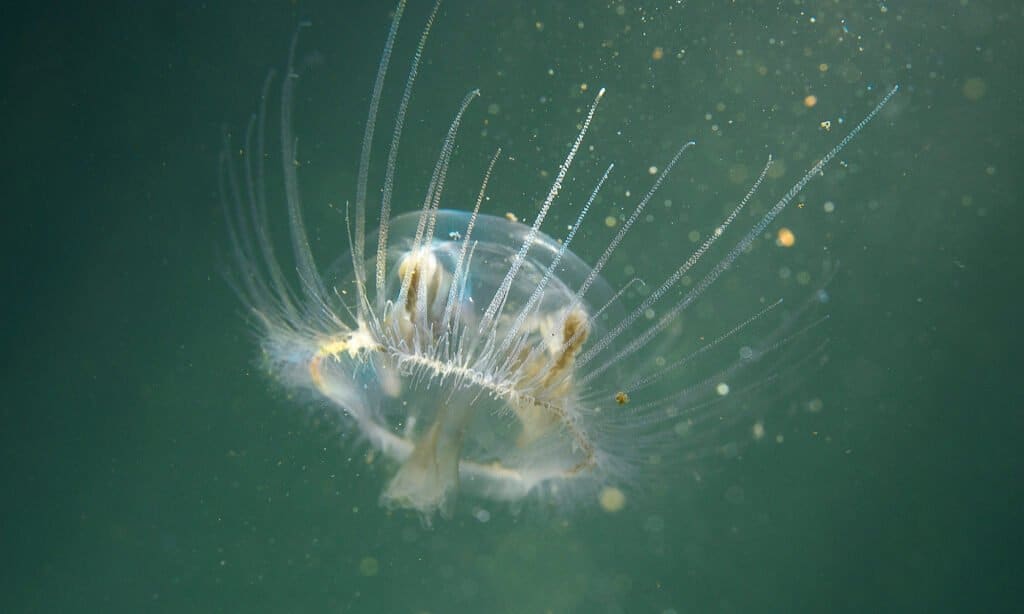Freshwater Jellyfish
Craspedacusta sowerbyi
The freshwater jellyfish is native to China but is now found all over the world
Advertisement
Freshwater Jellyfish Scientific Classification
- Kingdom
- Animalia
- Phylum
- Cnidaria
- Class
- Hydrozoa
- Order
- Limnomedusae
- Family
- Olindiidae
- Genus
- Craspedacusta
- Scientific Name
- Craspedacusta sowerbyi
Read our Complete Guide to Classification of Animals.
Freshwater Jellyfish Conservation Status
Freshwater Jellyfish Facts
- Prey
- Zooplankton
- Group Behavior
- Colony
- Fun Fact
- The freshwater jellyfish is native to China but is now found all over the world
- Estimated Population Size
- Millions
- Biggest Threat
- None
- Most Distinctive Feature
- Its resistance to drought
- Other Name(s)
- Peach blossom jellyfish
- Gestation Period
- days to months
- Diet
- Omnivore
- Common Name
- freshwater jellyfishh
- Number Of Species
- 1
View all of the Freshwater Jellyfish images!
“The most abundant jellyfish in the United States”
Many people might be shocked to learn that the tiny, harmless Craspedacusta sowerbyi, a hydromedusan jellyfish, is the most commonly found jellyfish in the United States. Moreover, it’s not found in the waters off the coasts, but in quiet bodies of freshwater. Where did it come from, and how on earth did it get into that flooded gravel pit in your neighborhood? Read on to find out.
Four Amazing Facts About the Freshwater Jellyfish
Here are four amazing facts about the freshwater jellyfish:
- A bloom of freshwater jellyfish is usually either all male or all female.
- The polyp of this freshwater jellyfish lacks tentacles, which is unusual.
- During times of cold weather or drought, the jellyfish turns into a podocyst. This is probably what allowed it to be carried all over the world from China.
- The jellyfish is so small that the stinging cells in its tentacles can’t penetrate human skin, so it is harmless to humans.
Freshwater Jellyfish Classification and Scientific name
The scientific name of the freshwater jellyfish is Craspedacusta sowerbyi. Craspedacusta comes from craspedon, an irregular New Latin word that means “velum ” and kystis, a Greek word for “bladder.” The species name is probably in honor of the Sowerby family of British naturalists. There’s only one species of C. sowerbyi, and no subspecies.
Freshwater Jellyfish Appearance
There are two mature forms of the C. sowerbyi, a polyp or a medusa. The medusa is shaped like a bell, with a structure called a velum attached to its underside. It is rarely more than an inch in diameter, translucent with a tinge of white or green and about 99 percent water. Inside the bell is the equivalent of a stomach, one circular canal and four canals that radiate out from the stomach. The stomach has a mouth with four lips, and the radial canals each bear a reproductive organ.
The polyp is shaped like a club. Only about 0.039 of an inch tall, it doesn’t have tentacles but a cap that holds nematocysts. It also has a mouth and holds on to a surface with a round base. It can contract to half its height or stretch to twice its height and can capture prey many times bigger than it is. Sometimes a colony of polyps can be seen eating the same prey.

Freshwater jellyfish weigh anywhere from 0.11 to 0.18 ounces.
©Rostislav Stefanek/Shutterstock.com
Freshwater Jellyfish Tentacles
The edge of the medusa’s bell bears as many as 400 tentacles of various lengths. The longer ones help the animal swim, while the shorter ones help it feed. These tentacles have cnidocytes which in turn hold nematocysts, which paralyze prey and pull it into the mouth. After the food is digested, the waste is expelled from the mouth. The tentacles also have eyespots at their tips.
Freshwater Jellyfish Distribution, Population, and Habitat
Native to China’s Yangtze River, this little jellyfish has managed to spread to bodies of freshwater in every continent on earth save Antarctica. It was first reported in Michigan in 1933 and Kentucky as early as 1916. It is found in the rivers and streams of Indiana, New York, Pennsylvania and much of the United States east of the Mississippi River. The only real requirement for this jellyfish is that the waters be calm.
The number of C. sowerbyi in any body of water increases depending on the temperature and the abundance of food. Still, it is difficult to determine the overall population, for newsworthy blooms can happen one year and not the next, even though conditions are similar. Maybe because of this C. sowerbyi’s conservation status is not evaluated.
Just how these jellyfish are distributed is the subject of a study by Indiana University in Pennsylvania.
Freshwater Jellyfish Predators and Prey
Freshwater jellyfish eat zooplankton, which are tiny animals found in the water. All the jellyfish has to do is extend its tentacles and wait for one of these animals to brush against them. The prey is then poisoned, paralyzed and drawn into the jellyfish’s mouth. C. sowerbyi prefers Daphnia and copepods as prey. In turn, the jellyfish is eaten by crayfish and turtles. Fish tend to avoid it.
Freshwater Jellyfish Reproduction and Lifespan
The most fascinating thing about C. sowerbyi is its reproduction. Though there are male and female jellyfish it is unusual for it to reproduce sexually. The medusa form, which looks like a “real” jellyfish, is only one of the forms the animal can take and is the most studied.
C. sowerbyi usually reproduces through budding. A polyp can grow a type of bud called a frustule. The frustule breaks off then turns into another polyp over time. Or, the polyp can grow a polyp bud, which can mature on the parent polyp until a colony is formed. The colony can also form a medusa bud. Eventually, the medusa bud breaks off and forms the familiar, mature jellyfish. If the jellyfish reproduces sexually it simply releases eggs or sperm into the water. The fertilized egg develops into a blastula, which develops into a planula larva, which settles on a surface and over time becomes a polyp.
Scientists aren’t sure how long C. sowerbyi lives, but if it is like most other jellyfish, it lives one or two years. During hard times of winter or drought, C. sowerbyi curls up into a nearly microscopic podocyst which is just a few cells encased in a hard shell. These podocysts stick to aquatic plants and the feet of waterbirds and are carried from one body of water to another.
Freshwater Jellyfish in Fishing and Cooking
C. sowerbyi is not deliberately fished nor is it used in cooking. Though other types of jellyfish are used in cooking, C. sowerbyi is too small and fragile.
Freshwater Jellyfish Population
It’s probably not wrong to believe there are millions of these freshwater jellyfish at any one time, but getting a precise handle on the population is an inexact science. In some years there will be abundant blooms of jellyfish, and in other years they are scarce.
View all 91 animals that start with FFreshwater Jellyfish FAQs (Frequently Asked Questions)
Are freshwater jellyfish harmful?
These jellyfish aren’t harmful, for their tentacles are too tiny to sting humans.
Is there any freshwater jellyfish?
There are freshwater jellyfish somewhere in some body of freshwater on earth.
Can you keep freshwater jellyfish?
It is possible to keep these jellyfish in an aquarium, but it can be challenging because the animals are so small and delicate. Among other things, the aquarium’s filtration system has to be calibrated so that it won’t ingest the jellyfish. The water should be still, and small fish should not be kept in the aquarium for the jellyfish might sting and kill them. They also need a steady supply of live food, whether it’s brine shrimp or Daphnia, which is the jellyfish’s favorite.
What lake has freshwater jellyfish?
Among the Great Lakes, Lake Huron which likes in Michigan and Ontario, has freshwater jellyfish. Other lakes in the United States that are known to have C. sowerbyi include Chapman Lake in Indiana and Lake Texoma in Oklahoma.
Thank you for reading! Have some feedback for us? Contact the AZ Animals editorial team.
Sources
- , Available here: https://www.itis.gov/servlet/SingleRpt/SingleRpt?search_topic=TSN&search_value=50776#null
- , Available here: http://winvertebrates.uwsp.edu/francart_361_2012.html
- , Available here: http://people.se.cmich.edu/mcnau1as/zooplankton%20web/craspedacusta2/craspedacusta.htm
- , Available here: https://nas.er.usgs.gov/queries/factsheet.aspx?SpeciesID=1068
- , Available here: https://nas.er.usgs.gov/queries/factsheet.aspx?SpeciesID=1068
- , Available here: http://lifeinfreshwater.net/freshwater-jellyfish-craspedacusta-sowerbyi/
- , Available here: https://media.dlib.indiana.edu/media_objects/6108vb37d

















